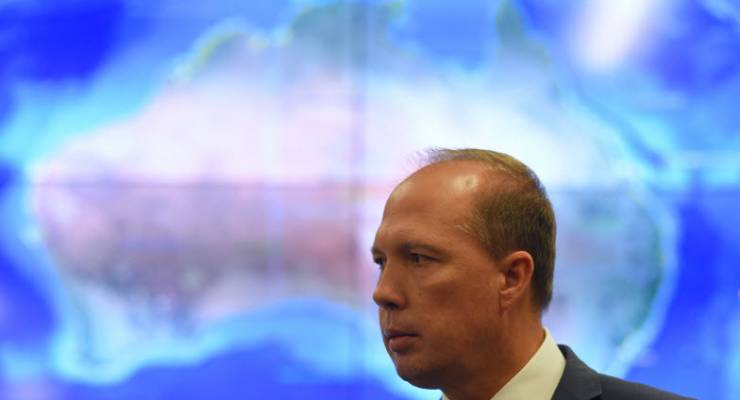
Imagine arriving at an Australian airport and being “whisked through Customs” without having to show your passport, not have to fill out those asinine inbound passenger cards. No queueing or exchanges with a surly Customs officer, simply being waved through with biometric data using facial recognition, iris and fingerprint technology. Marvellous, huh?
“This will make it easier, it will make it quicker, for people going in and out of our airports,” Immigration minister Peter Dutton told one of several media outlets that happily gave the government the headlines and TV coverage it wanted yesterday. The taxpayer-funded defence industry spruikers at the Australian Strategic Policy Institute waxed lyrical about the proposal in one piece, enthusing that “it could be a world first.” Dutton wants 90% of passengers being processed using facial, iris or fingerprint recognition systems.
Only problem is, this is a stealth means of achieving what the government has already tried once to do, and failed.
In 2014, the Immigration Department used the cover of the Abbott government’s foreign fighters to attempt a remarkable extension of government surveillance powers: it proposed to give itself the power — which would be done by regulation, not legislation, reducing accountability and transparency — to collect “personal identifiers”, including iris and fingerprint scans, of every person entering or leaving Australia, and store that information.
This is the same department that has an astonishing record of poor data security, including releasing the data of ten thousand asylum seekers, and which just last week was heavily criticised by the Australian National Audit Office for its appalling data collection and retention practices in its administration of offshore processing. And unlike, say, credit card details, once your biometric information is stolen or published accidentally by Immigration, there’s no changing it to keep it safe from criminals.
A sharp-eyed Labor MP, Anthony Byrne, spotted what Immigration was attempting to do in Joint Committee on Intelligence and Security hearings in 2014 and hammered Immigration on it — particularly on the complete lack of safeguards over mission creep for the data. Caught out, Immigration ditched the proposal. It failed to get the power to take your biometric data whenever you walked through an airport.
But now it’s back, under a friendlier guise — just give Immigration your fingerprints and iris pattern and you can enjoy a queue-free, paperless Customs experience. Except, it’s exactly the same proposal — and this time will be implemented by the private sector. This is the anodyne description of what is proposed in the Request for Tender:
“Automated Border Control or S2 or Primary Line — supply, implement and maintain a replacement Australian Border Control solution that will eliminate the need for physical tickets and have the ability to process travellers using ‘contactless’ technology, removing the need for some travellers to present their passport”
And while the tenderer is required not to be listed as a terrorist — Al Qaeda is doubtless furious that it has been ruled out — “must be financially and commercially viable to perform the Services” and must not have a record of not paying employee entitlements, there are no requirements for a demonstrated record of securing personal information or protecting citizens’ privacy.
It must also raise questions about what is being called “the capability”. A new facial recognition tool announced by the government in 2015 to allow agencies to match up photos of people being investigated with the photos or CCTV footage of people they already have on file across government. The new Immigration system will not only give the government photos of everyone with an Australian passport, but everyone passing through Customs.








What a tasty bait Dutton offers to the tired traveller – no more queues. As if.
His credibility remains consistent ie: nil.
So is someone suggesting we won’t need passports? How would we prove our identity when we arrive at our destination, or prove our identity in Australia, say when opening a bank account?
How is Peter Dunce-stan a Minister of the Crown?
He couldn’t exactly stay as a copper after Sir Terry stepped down.
Yeah, because Census 2016, Centrelink Data Matching, NBN and everything else has worked so very well ……
And just remember that when photo driver licences were introduced it was sworn up hil & down dale that the data would not be shared with other agencies but of course they wuz jes’ joking.
Anyone who doesn’t imagine that this technology, once perfected, will not be introduced at all possible venues, from train stations to Centrelink might be interested in a bridge & perpetual motion machine I’m selling.